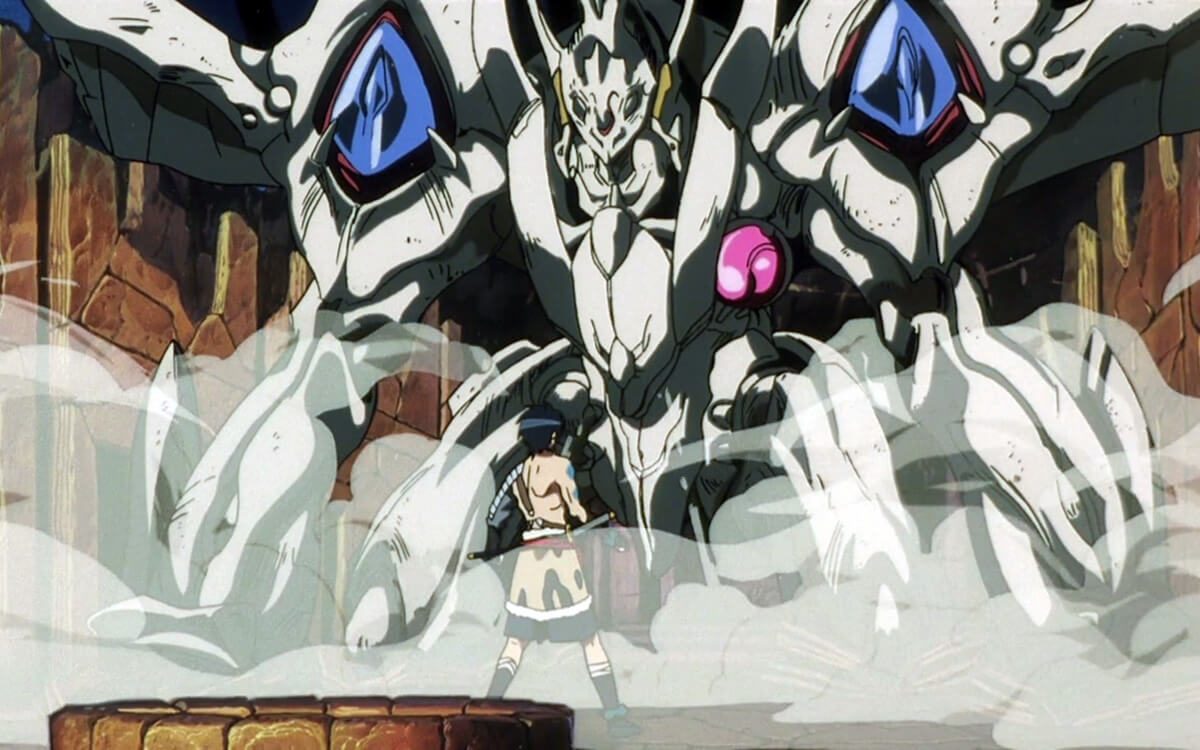
I walked into the Escaflowne movie having seen none of the series it’s based on. And based upon my reaction to the movie, that might not have been a good thing. An edited retelling of the series’ events, the movie certainly lacks nothing when it comes to visual flair and appeal, but it feels very lacking in almost every other department. Or rather, it tries to compensate for its lack by going overboard in the “cheesy melodrama” department. And that’s a real shame, because it gets off to such a great start.
The film kicks off with a lone warrior storming an airship belonging to the Black Dragon clan. He quickly dispatches the crew in a thrilling (and very bloody) swordfight that ranks right up with those in Ninja Scroll or the Samurai X OAVs. The object of his assault is Escaflowne, a giant, mysterious suit of armor. The movie suddenly shifts to the “real” world, where we find our heroine, Hitomi, daydreaming on the roof of her school.
Disaffected and alienated, Hitomi senses no purpose for her life. She drifts through the days, wishing to fade away from her senseless life. After driving off her last friend, Hitomi has a vision of a kindred spirit beckoning her to another world. In this world, she can make sense of her life. Before she can react, she’s swallowed up by an ocean that appears out of nowhere, only to find herself trapped inside Escaflowne.
Hitomi is now in Gaea, a sort of parallel world. Here, the appearance of Earth in the sky signals the arrival of the Wing Goddess, one who will awaken Escaflowne and either destroy, or remake Gaea. Hitomi meets Van, the swordsman from before, who is revealed to be the deposed leader of the Dragon Clan. Van desires to use Escaflowne to defeat the Black Dragon clan, and free Gaea.
When Escaflowne mysteriously disappears after their meeting, Van immediately doubts Hitomi is the Wing Goddess (Hitomi has no idea what he’s talking about), suspecting she’s a spy. However, he’s assigned to protect her against the Black Dragon clan, who is keen on getting her back and harnessing Escaflowne. Hitomi now finds herself amidst the Abaharaki, a motley group of rebels fighting the Black Dragon clan and their enslavement of Gaea’s peoples.
All of this happens in about the first 30 minutes, which makes some of the details blur together. After a thrilling battle scene where the Black Dragons attack the Abaharaki to capture Hitomi, the movie begins its spiral into melodrama. One minute, Hitomi is innocent and naive, and the next, she’s pledging her life to Van in a longwinded speech that not even Hallmark would use in their cards.
In fact, it seems like the movie spends much of the time building up to these moments, where characters go off on rants about overcoming their loneliness and finding their purpose in life. I suppose these are the movie’s attempts at being meaningful and moving, but it does feel rather blatant. It’s a shame that so much effort is spent here, because the freedom fighters’ motley crew offers so many interesting options for character development. Aside from a few scenes, they’re left undeveloped (something I assume doesn’t happen in the series) and seem largely forgotten.
Even Hitomi and Van feel paper thin at times. Again, I’m assuming that much of their relationship’s development was left out of the movie, but is explored in greater detail in the series. As it stands, Hitomi’s character takes the biggest hit. Much of her emotional turmoil from the movie’s first third gets a short shrift later on, washed away with one tearjerker of a speech after another.
However, the series’ melodrama is almost offset by the movie’s visual style. Almost. In a word, Escaflowne is gorgeous. The world of Gaea is just lovely to look at. A lot of care obviously went into designing and animating the world of Escaflowne, including its inhabitants. Gaea is populated by an interesting mix of races and species (picture an anime version of Narnia), and each one is interesting in their own right. And the set pieces, especially the airships and floating city of the Black Dragon clan, are designed such that they feel both alien and familiar, enhancing the idea that Gaea is a world parallel to our own.
This attention to detail and animation also spills over into the battles that are sprinkled throughout the movie. Whether it be with swords or magical powers, Escaflowne’s battles are a thrill to watch, and are surprisingly vicious and bloody (especially the opening scene). But this only applies to battles between the (in)human characters. It’s kind of ironic that, in a movie that centers on the discovery of a giant battlesuit, the final showdown between Escaflowne and another giant mecha is the weakest battle of the bunch.
There’s one other element that I need to mention, and that’s Yoko Kanno’s score. You might recognize Kanno’s name from Macross Plus (which is just devastatingly beautiful at times), Cowboy Bebop (possibly some of the best theme music ever), and Brain Powered. Kanno’s score is appropriately cinematic and epic, but also contains some gentle, moving moments. I love Kanno’s work, and am almost tempted to try and track down the soundtrack alone.
I suppose I should watch the Escaflowne series before I judge the movie too harshly. But if the series is as melodramatic as the movie, then I think I’ll take my time. One of the special features on the DVD are trailers for other feature length movies, including Gundam Wing: Endless Waltz and Jin-Roh. I think it’s a little more than telling that Jin-Roh’s trailer alone had me shivering with excitement, even though I’ve already seen the movie. On the other hand, I had to suppress a groan throughout much of Escaflowne’s latter half.
